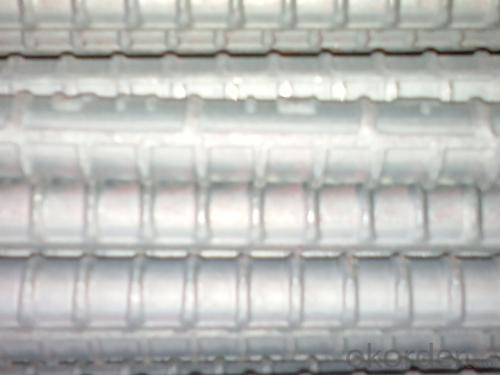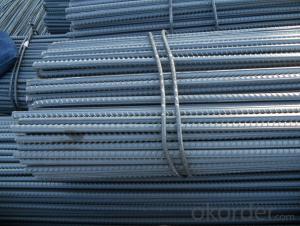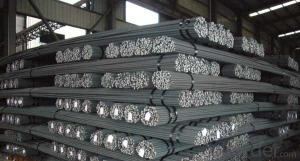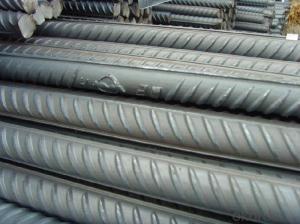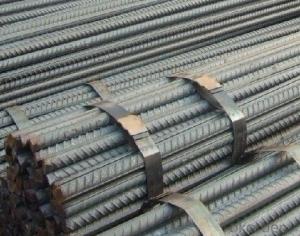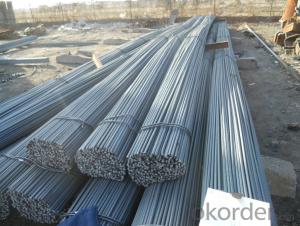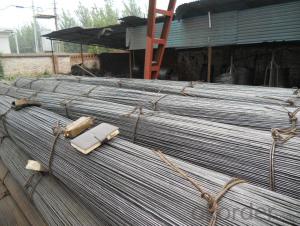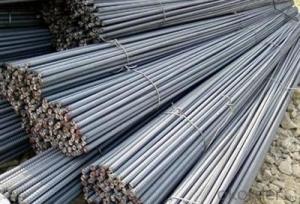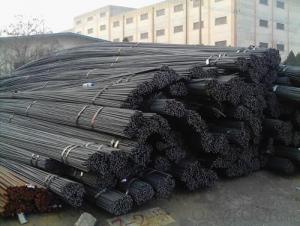Deformed Steel Rebar for Construction Steel with Different Function
- Loading Port:
- China main port
- Payment Terms:
- TT or LC
- Min Order Qty:
- 50 m.t.
- Supply Capability:
- 200000 m.t./month
OKorder Service Pledge
OKorder Financial Service
You Might Also Like
Deformed Steel Rebar for Construction Steel with Different Function
Theoretical weight and section area of each diameter as below for your information:
Diameter(mm) | Section area (mm²) | Mass(kg/m) | Weight of 12m (kg) | Pcs/ton |
6 | 28.27 | 0.222 | 2.664 | 375.38 |
8 | 50.27 | 0.395 | 4.74 | 210.97 |
10 | 78.54 | 0.617 | 7.404 | 135.06 |
12 | 113.1 | 0.888 | 10.656 | 93.84 |
14 | 153.9 | 1.21 | 14.52 | 68.87 |
16 | 201.1 | 1.58 | 18.96 | 52.74 |
18 | 254.5 | 2.00 | 24 | 41.67 |
20 | 314.2 | 2.47 | 29.64 | 33.74 |
22 | 380.1 | 2.98 | 35.76 | 27.96 |
25 | 490.9 | 3.85 | 46.2 | 21.65 |
28 | 615.8 | 4.83 | 57.96 | 17.25 |
32 | 804.2 | 6.31 | 75.72 | 13.21 |
36 | 1018 | 7.99 | 98.88 | 10.43 |
40 | 1257 | 9.87 | 118.44 | 8.44 |
50 | 1964 | 15.42 | 185.04 | 5.40 |
The production process of Deformed Steel Rebar for Construction Steel with Different Function
1-Waling beam furnace 2-Roughing rolling group 3-Intermediate rolling train
4-Finishing rolling group 5-Water-cooling device 6-Walking beam cooler
7-Finishing equipment(including the cold scale shear,short feet collection system,
automatic counting device,bundling machine, collect bench)
Usage and Applications of Deformed Steel Rebar for Construction Steel with Different Function
Deformed bar is widely used in buildings, bridges, roads and other engineering construction. Big to highways, railways, bridges, culverts, tunnels, public facilities such as flood control, dam, small to housing construction, beam, column, wall and the foundation of the plate, deformed bar is an integral structure material. With the development of world economy and the vigorous development of infrastructure construction, real estate, the demand for deformed bar will be larger and larger..
Packaging & Delivery of Deformed Steel Rebar for Construction Steel with Different Function
Packaging Detail: products are packed in bundle and then shipped by container or bulk vessel, deformed bar is usually naked strapping delivery, when storing, please pay attention to moisture proof. The performance of rust will produce adverse effect.
Each bundle weight: 2-3MT, or as required
Payment terms: TT payment in advance or Irrevocable LC at sight.
Trade terms :FOB, CFR, CIF
Label:to be specified by customer, generally, each bundle has 1-2 labels
Pictures of Deformed Steel Rebar for Construction Steel with Different Function

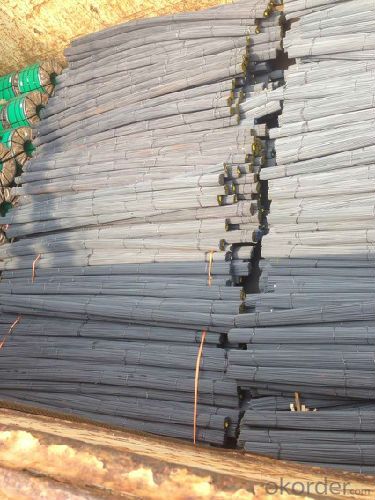
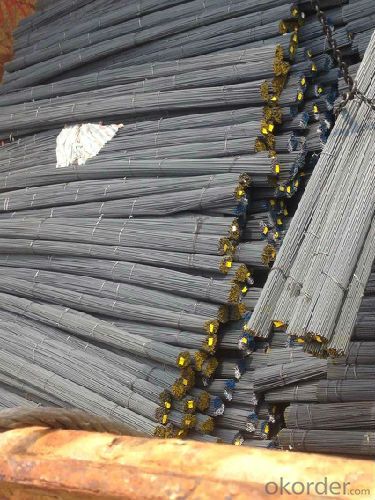
Note:
1. Our products are produced according to national standard (GB), if not, supply according to national standards (GB) or agreement as customer required.
2. Other Grade and Standard Deformed Steel Bar we can supply:
Grade: GR40/GR60, G460B/B500A/B500B/B500C,BST500S
Standard: ASTM, BS, DIN
The Minimum Order Quantity of these products is high, and need to be confirmed.
3. We can not only supply Deformed Steel Bar; if you need anything about building materials, please contact us for further information.
4. Please send us your detail specifications when inquire. We will reply to you as soon as possible. We sincerely hope we can establish a long stable business relationship.
- Q: Can steel rebars be used in the construction of underground parking structures?
- Yes, steel rebars can be used in the construction of underground parking structures. Steel rebars are commonly used in reinforced concrete structures, including underground parking structures, to provide tensile strength and reinforcement. The rebars are typically placed strategically within the concrete to enhance its load-bearing capacity, durability, and resistance to cracking or deformation. Due to their high strength and ability to withstand heavy loads, steel rebars are well-suited for underground parking structures that require robust structural support. Additionally, the corrosion resistance of steel rebars can be further enhanced by applying protective coatings or using stainless steel rebars, which is particularly important in underground environments where moisture and exposure to chemicals may be present. Overall, the use of steel rebars is a standard practice in the construction of underground parking structures to ensure the structural integrity and longevity of the facility.
- Q: What are the common myths and misconceptions about steel rebars?
- There are several common myths and misconceptions about steel rebars. One misconception is that all rebars are the same, when in fact there are different grades and types of rebars with varying properties and strengths. Another myth is that steel rebars are prone to rusting easily, but in reality, rebars are typically coated with protective substances or used in conjunction with concrete to prevent corrosion. Additionally, some people believe that steel rebars are not environmentally friendly, but they are actually highly recyclable and can be reused in various construction projects. Overall, it's important to dispel these myths and understand the true characteristics and benefits of steel rebars in construction.
- Q: How do steel rebars affect the flexibility of a structure?
- Steel rebars can significantly enhance the flexibility of a structure. By reinforcing concrete, rebars help distribute and withstand loads, increasing the overall strength and durability of the construction. This reinforcement allows for more flexibility in design, as it provides the structural integrity necessary to support various architectural configurations and withstand dynamic forces.
- Q: What are the different types of steel rebars used in marine structures?
- The different types of steel rebars used in marine structures include epoxy-coated rebars, stainless steel rebars, and galvanized rebars. Epoxy-coated rebars are coated with epoxy to provide protection against corrosion. Stainless steel rebars are highly resistant to corrosion and are commonly used in environments with high chloride content. Galvanized rebars are coated with a layer of zinc to protect against corrosion and are suitable for marine structures with low to moderate corrosion risks.
- Q: How do steel rebars impact the overall flexibility of a structure?
- Steel rebars, also referred to as reinforcing bars, play a crucial role in enhancing the overall flexibility of a structure. These bars are typically utilized in reinforced concrete structures to bolster tensile strength and enhance the structural integrity of the building. The integration of steel rebars in concrete significantly augments the flexibility of a structure. Concrete itself possesses strength in compression but weakness in tension. By incorporating rebars, the structure becomes more adept at withstanding tensile forces and resisting bending or deformation caused by external loads or environmental factors. The rebars function as reinforcement by assimilating and dispersing tensile forces throughout the structure, aiding in the prevention of cracks and ensuring a more uniform distribution of stress. This is particularly vital in regions prone to seismic activity or high wind loads, where structures must possess the ability to flex and absorb the energy exerted upon them. Furthermore, the presence of steel rebars also permits the creation of thinner and lighter concrete sections. This contributes to the overall flexibility of the structure by reducing the dead load, rendering it more responsive and adaptable to diverse conditions. In summary, steel rebars have a significant impact on the overall flexibility of a structure by furnishing tensile strength, averting cracks, distributing stress, and enabling the implementation of lighter and thinner concrete sections. By enhancing the structural integrity and resilience, the inclusion of rebars ensures that the building can withstand external forces while preserving its stability and flexibility, ultimately contributing to its longevity and safety.
- Q: What is the maximum allowable stress for steel rebars?
- The maximum allowable stress for steel rebars is typically determined by design codes and standards, which vary depending on the specific application and country. However, in general, the maximum allowable stress for steel rebars is usually around 0.6 times the yield strength of the steel.
- Q: Are steel rebars susceptible to corrosion?
- Steel rebars can be corroded, as corrosion is a natural occurrence when steel is exposed to moisture, oxygen, and other environmental factors. In concrete structures, the rebars are exposed to the elements and can come into contact with water or moisture, resulting in the formation of rust. This rust weakens the rebars and can ultimately compromise the concrete's structural integrity. Preventive measures can be taken to avoid corrosion, including applying a protective coating or using rebars made of corrosion-resistant steel. It is crucial to regularly maintain and inspect concrete structures to promptly identify and address any signs of corrosion.
- Q: What is the maximum allowable percentage of rust on steel rebars?
- The maximum allowable percentage of rust on steel rebars is typically 5%. However, this may vary depending on specific industry standards and project requirements.
- Q: What is the average lifespan of steel rebars in concrete structures?
- The average lifespan of steel rebars in concrete structures can vary depending on various factors such as the quality of the steel, environmental conditions, and maintenance practices. However, under normal conditions, steel rebars in concrete structures are expected to have a lifespan of around 50 to 100 years.
- Q: What are the advantages of using galvanized steel rebars?
- Using galvanized steel rebars in construction projects offers several advantages. Firstly, the rebars are protected by a zinc coating that prevents corrosion, ensuring their durability and longevity. Unlike traditional steel rebars that may rust, the zinc coating acts as a barrier against moisture and other corrosive elements, preserving the structure's integrity. Secondly, galvanized steel rebars have a high ratio of strength to weight. This means they are both lightweight and incredibly strong, making them ideal for reinforced concrete structures. Their strength allows for the use of thinner and lighter rebars, reducing the overall weight of the structure and increasing cost-effectiveness. Additionally, working with and installing galvanized steel rebars is easy. They can be cut, bent, and shaped to meet specific project requirements. This ease of handling enables faster construction, saving both time and money. Furthermore, galvanized steel rebars are fire-resistant. The zinc coating acts as a protective layer, preventing them from burning or sustaining damage from high temperatures. This fire resistance is crucial for ensuring the stability and safety of structures, particularly in fire-prone areas or where fire safety regulations are strict. Lastly, galvanized steel rebars are environmentally friendly. The zinc coating used in the galvanization process is non-toxic and recyclable. This means that at the end of their lifespan, galvanized steel rebars can be easily recycled and reused, minimizing waste and reducing their environmental impact. In conclusion, the advantages of galvanized steel rebars include corrosion resistance, a high strength-to-weight ratio, ease of installation, fire resistance, and environmental friendliness. These benefits make them a popular and trustworthy choice for reinforcing concrete structures in various construction projects.
Send your message to us
Deformed Steel Rebar for Construction Steel with Different Function
- Loading Port:
- China main port
- Payment Terms:
- TT or LC
- Min Order Qty:
- 50 m.t.
- Supply Capability:
- 200000 m.t./month
OKorder Service Pledge
OKorder Financial Service
Similar products
Hot products
Hot Searches
Related keywords



